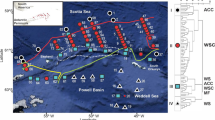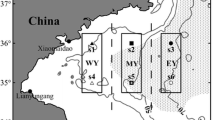Abstract
The horizontal and vertical distribution and population structure of euphausiids in the Ross Sea and its adjacent waters were investigated during the summers of 2004/2005 using stratified towed samples. Nine species of euphausiids occurred in the survey area. Among them, Euphausia triacantha was dominant in biomass north of the southern boundary of the Antarctic circumpolar current (SB). Thysanoessa spp. was widely distributed north of the continental slope, while E. superba was distributed from the SB to the slope, where it showed the highest biomass. Juvenile E. superba was distributed offshore near the SB and remained at the surface, but gravid females were dominant in the slope and mainly occurred in the middle layers (400–600 m). Adult and juvenile E. crystallorophias were found at 200–300 m in the colder water of the continental shelf. In general, the peak biomass of euphausiids was found in the mid layers of the Ross Sea area. The life span and the number of spawns for major species are also discussed.










Similar content being viewed by others
References
Ainley DG (1985) The biomass of birds and mammals in the Ross Sea, Antarctica. In: Siegfried WR, Condy PR, Laws RM (eds) Antarctic nutrient cycles and food webs. Springer, Heidelberg , pp 498–515
Ainley DG (2004) Acquiring a “base datum of normality” for a marine ecosystem: the Ross Sea, Antarctica. SC-CCAMLR WG-EMM-04/20: 1–19
Ainley DG, O’Connor EF, Boekelheide RJ (1984) The marine ecology of birds in the Ross Sea, Antarctica. Ornithol Monogr 32:1–97
Ainley DG, Ballard G, Dugger KM (2006) Competition among penguins and cetaceans reveals trophic cascades in the Ross Sea, Antarctica. Ecology 87:2080–2093
Anon (1986) Post FIBEX acoustic workshop. BIOMASS Report Series, No 40, Scientific Committee Antarctic Research, Cambridge, England, 1–106
Ashjian CJ, Rosenwaks GA, Wiebe PH, Davis CS, Gallager SM, Copley NJ, Lawson GL, Alatalo P (2004) Distribution of zooplankton of the continental shelf off Marguerite Bay, Antarctic Peninsula, during Austral fall and winter, 2001. Deep-Sea Res II 51:2073–2098
Azzali M, Leonori I, Felice ADE, Russo A (2006) Spatial-temporal relationships between two euphausiid species in the Ross Sea. Chem Ecol 22:S219–S233
Baker A de C, Clarke MR, Harris MJ (1973) The N.I.O combination net (RMT 1 + 8) and further developments of Rectangular Midwater Trawls. J Mar Biol Assoc UK. 53: 176–184
Brinton E (1985) The oceanographic structure of the eastern Scotia Sea-III. Distributions of euphausiid species and their developmental stages in 1981 in relation to hydrography. Deep Sea Res 32:1153–1180
Brinton E, Ohman MD, Townsend AW, Knight MD, Bridgeman AL (1999) Euphausiids of the World Ocean. World Biodiversity Database CD-ROM series. ETI Expert Center for Taxonomic Identification
Callahan JE (1972) The structure and circulation of deep water in the Antarctic. Deep-Sea Res 19:563–575
Southampton Oceanography Centre (2004) RMT 1 + 8 Multinet Coaxial Cable Version, Operations Manual Issue 4, September 2004. In: White D (ed). Southampton Oceanography Centre, Southampton, 1–31
Demer DA, Hewitt RP (1995) Bias in acoustic biomass estimates of Euphausia superba due to diel vertical migration. Deep Sea Res I 42:455–475
Everson I (1987) Some aspects of the small scale distribution of Euphausia crystallorophias. Polar Biol 8:9–15
Everson I (2000) Role of krill in marine food webs 7.3 The Southern Ocean. In: Everson I (ed) Krill: biology, ecology and fisheries. Blackwell , Oxford, pp 194–201
Hopkins TL (1987) Midwater food web in McMurdo Sound, Ross Sea, Antarctica. Mar Biol 96:93–106
Ichii T, Shinohara N, Fujise Y, Nishiwaki S, Matsuoka K (1998a) Interannual changes in body fat condition index of minke whales in the Antarctic. Mar Ecol Prog Ser 175:1–12
Ichii T, Katayama K, Obitsu N, Ishii H, Naganobu M (1998b) Occurrence of Antarctic krill (Euphausia superba) concentrations in the vicinity of the South Shetland Islands: relationship to environmental parameters. Deep-Sea Res I 45:1235–1262
Ichii T, Bengtson JL, Boveng PL, Takao Y, Jansen JK, Hiruki-Raring LM, Cameron MF, Okamura H, Hayashi T, Naganobu M (2007) Provisioning strategies of Antarctic fur seals and chinstrap penguins produce different responses to distribution of common prey and habitat. Mar Ecol Prog Ser 344:277–297
John DD (1936) The southern species of the genus Euphausia. Discov Rep 14:193–324
Kooyman GL, Kooyman TG (1995) Diving behavior of emperor penguins nurturing chicks at Coulman Island, Antarctica. Condor 97:536–549
La Mesa M, Eastman JT, Vacchi M (2004) The role of notothenioid fish in the food web of the Ross Sea shelf waters: a review. Polar Biol 27:321–338
Lancraft TM, Reisenbichler KR, Robinson BH, Hopkins TL, Torres JJ (2004) A krill-dominated micronekton and macrozooplankton community in Croker Passage, Antarctica with an estimate of fish predation. Deep-Sea Res II 51:2247–2260
Lascara CM, Hofmann EE, Ross RM, Quetin LB (1999) Seasonal variability in the distribution of Antarctic krill, Euphausia superba, west of the Antarctic Peninsula. Deep Sea Res 46:951–984
Lawson GL, Wiebe PH, Ashjian CJ, Stanton TK (2008) Euphausiid distribution along the Western Antarctic Peninsula-Part B: distribution of euphausiid aggregations and biomass, and associations with environmental features. Deep-Sea Res II 55:432–454
Macdonald PDM, Green PEJ (1988) User’s Guide to Program MIX: an interactive program for fitting mixtures of distributions. Release 2.3, January 1988. Ichthus Data Systems, Hamilton, Ontario, iv + 60 pp
Makarov PR, Denys CJ (1981) Stages of sexual maturity of Euphausia superba, Dana. Biomass Handb 11:1–13
Mauchline J (1980) Key for the identification of Antarctic euphausiids. Biomass Handb 5:1–4
Miller DGM, Hampton I (1989) Biology and ecology of Antarctic krill (Euphausia superba Dana): a review. BIOMASS Sci Ser 9:1–166
Nemoto T (1966) Thysanoessa euphausiids, comparative morphology, allomorphosis and ecology. Sci Rep Whales Res Inst 20:109–155
Nicol S (2006) Krill, currents, and sea ice: Euphausia superba and its changing environment. BioScience 56:111–120
Nicol S, Kitchener J, King R, Hosie G, de la Mare WK (2000) Population structure and condition of Antarctic krill (Euphausia superba) off East Antarctica (80–150°E) during the Austral summer of 1995/1996. Deep-Sea Res II 47:2489–2517
Nordhausen W (1992) Distribution and growth of larval and adult Thysanoessa macrura (Euphausiacea) in the Bransfield Strait Region, Antarctica. Mar Ecol Prog Ser 83:185–196
Nordhausen W (1994) Winter abundance and distribution of Euphausia superba, E. crystallorophias, and Thysanoessa macrura in Gerlache Strait and Crystal Sound, Antarctica. Mar Ecol Prog Ser 109:131–142
O’Brien DP (1987) Direct observations of the behavior of Euphausia superba and Euphausia crystallorophias (crustacean: Euphausiacea) under pack ice during the Antarctic spring of 1985. J Crust Biol 7:437–448
Orsi AH, Whitworth III, Nowlin WD Jr (1995) On the meridional extent and fronts of the Antarctic Circumpolar Current. Deep-Sea Res I 42:641–673
Pakhomov EA (1995) Demographic studies of Antarctic Euphausia superba in the Cooperation and Cosmonaut Seas (Indian sector of the Southern Ocean). Mar Ecol Prog Ser 119:45–61
Pakhomov EA (2000) Demography and life cycle of Antarctic krill, Euphausia superba, in the Indian sector of the Southern Ocean: long-term comparison between coastal and open-ocean regions. Can J Fish Aquat Sci 57(Suppl 3):68–90
Pakhomov EA, Perissinotto R (1996) Antarctic neritic krill Euphausia crystallorophias: spatio-temporaldistribution, growth and grazing rates. Deep-Sea Res 43:59–87
Pakhomov EA, Perissinotto R, Froneman PW (1998) Abundance and trophodynamics of Euphausia crystallorophias in the shelf region of the Lazarev Sea during austral spring and summer. J Mar Syst 17:313–324
Panigada S, Zanardelli M, Canese S, Jahoda M (1999) How deep can baleen whales dive? Mar Ecol Prog Ser 187:309–311
Pennak RW (1943) An effective method of diagramming diurnal movements of zooplankton organisms. Ecology 24:405–407
Quetin L, Ross R (2001) Environmental variability and its impact on the reproductive cycle of Antarctic krill. Am Zool 41:74–89
Russo A (2000) Water masses characteristic during the ROSSMIZE cruise (western sector of the Ross Sea, November-December, 1994). In: Faranda FM, Guglielmo L, Ianora A (eds) Ross sea ecology. Springer, Berlin, pp 83–93
Sala A, Azzali M, Russo A (2002) Krill of the Ross Sea: distribution, abundance and demography of Euphausia superba and Euphausia crystallorophias during the Italian Antarctic Expedition (January–February 2000). Sci Mar 66:123–133
Siegel V (1987) Age and growth of Antarctic Euphausiacea (Crustacea) under natural conditions. Mar Biol 96:483–495
Siegel V (1988) A concept of seasonal variation of krill (Euphausia superba) distribution and abundance west of the Antarctic Peninsula. In: Sahrhage D (ed) Antarctic Ocean and resources variability. Springer, Heidelberg, pp 219–230
Siegel V (1989) Winter and spring distribution and status of the krill stock in Antarctic Peninsula waters. Arch FischWiss 39:45–72
Siegel V (1992) Review of length-weight relationships for Antarctic krill. CCAMLR Sel Sci Pap 9:145–155
Siegel V (2005) Distribution and population dynamics of Euphausia superba: summary of recent findings. Polar Biol 29:1–22
Siegel V, Harm U (1996) The composition, abundance, biomass and diversity of the epipelagic zooplankton communities of the southern Bellingshausen Sea (Antarctic) with special reference to krill and salps. Arch Fish Mar Res 44:115–139
Siegel V, Loeb V (1995) Recruitment of Antarctic krill Euphausia superba and possible causes for its variability. Mar Ecol Prog Ser 123:45–56
Siegel V, Skibowski A, Harm U (1992) Community structure of the epipelagic zooplankton community under ther sea-ice of the northern Weddell Sea. Polar Biol 12:15–24
Siegel V, Kawaguchi S, Ward P, Litvinov F, Sushin V, Loeb V, Watkins J (2004) Krill demography and large-scale distribution in the southwest Atlantic during January/February 2000. Deep-Sea Res II 51:1253–1273
Yabuki T (2006) Hydrography of the Antarctic Ocean and its variability based on JARPA and R/V Kaiyo Maru survey. Dr Thesis, Tohoku University, Sendai, 1–107
Zhou M, Dorland RD (2004) Aggregation and vertical migration behavior of Euphausia superba. Deep-Sea Res II 51:2119–2137
Acknowledgments
We would like to express our sincere gratitude to Taro Ichii, Hiroto Murase, Shigeyuki Kawahara and Tsutomu Tamura for their kindness in critically reading the manuscript and invariable comments for the manuscript. We are grateful to officers and crew of the R.V. Kaiyo-maru, Fisheries Agency, for their devoted assistance with the collection of samples. Thanks are also due to Yuko Watanabe and Kazuyuki Korenaga, for their kind help in collecting and sorting samples.
Author information
Authors and Affiliations
Corresponding author
Rights and permissions
About this article
Cite this article
Taki, K., Yabuki, T., Noiri, Y. et al. Horizontal and vertical distribution and demography of euphausiids in the Ross Sea and its adjacent waters in 2004/2005. Polar Biol 31, 1343–1356 (2008). https://doi.org/10.1007/s00300-008-0472-6
Received:
Revised:
Accepted:
Published:
Issue Date:
DOI: https://doi.org/10.1007/s00300-008-0472-6




